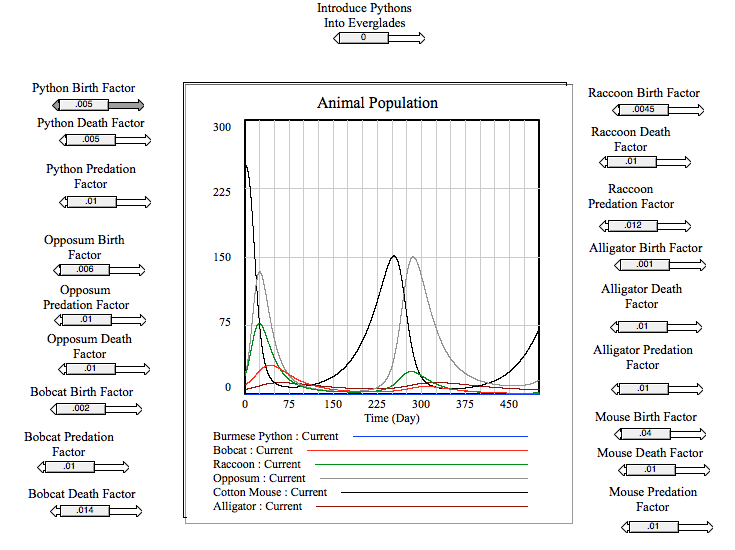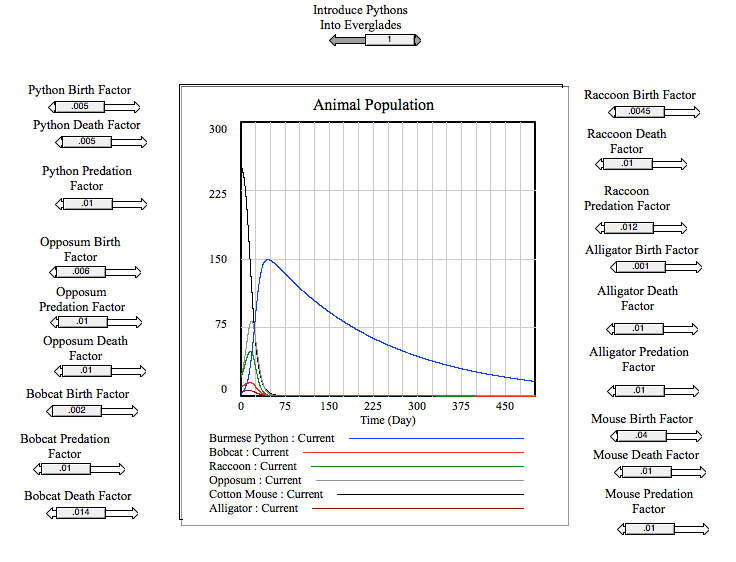Summer Project
Overview
This project models the Burmese python as an invasive species in the Evergalades. Burmese pythons are one of the most popular snake pet species. However, they grow very fast and large, so when owners are unable to take care of them, the snakes are released into the wild. The python, when in the Everglades, has no natural predators. The only animal that has been shown to eat the pythons is the alligator, but the python has also eaten alligators before. This model demonstrates the negative impact that the burmese python has on native species in the Everglades, specifically the alligator, raccoon, opossum, mouse, and bobcat.
Basic Story: They python will eat any animal, but there is some chance that the alligator will eat it instead. The alligator is just like the python, but reproduces less. The bobcat will eat the mouse, opossum, and racoon. Both the opossum and raccoon will eat the mouse. All the animals age at the same rate, but die at different ages. The animals also need different levels of food to reproduce. All animals move randomly on land, but the python and alligator can move in water as well.
System Model
This model requires the program VensimPLE to run, which is a free system modeling software. To download the software, please click here. To run the model, click on the Simulate button. To adjust parameters such as the ant birth, click SyntheSim, which allows you to adjust variables in the program. By switching the variable 'Introduce Python Into Everglades' to 1, the pythons are added into the model, and are removed at zero.


Model Results: In this model, each animal interacts together to form a food web. When the pythons are absent, the graph shows a stable environment: the low-level animals (i.e. the mice) have high populations, and the high-level animals (i.e. the alligators and bobcats) have low populations. However, the populations remain consistent throughout the duration of the model. This simulates accurately what a stable environment would look like, with no animal taking over the other. However, when the python is introduced into the model, there is rapid and immediate change. The python easily overpowers the other animals, decimating their populations. It devours the other animals at an extreme rate, and almost immediatly wipes out entire animal species. Afterwards, the pythons begin to slowly die off as there is no food remaining. In real life, this sort of change takes longer to occur, but this model is relatively close to what has been happening in the Everglades, and to what is predicted to occur without intervention.
Agent Model
These agent models are made in a website called AgentCubesOnline. The models show the relationships between individual creatures.
Each model links to a page with three options: Play, Design, and Edit. Play allows you to watch the model run up close, design allows you to add or remove individual agents, and edit allows you to change everything about the model, from the code that governs agents to the size of the world.
To start the model, click play. To stop the model, hit the back button on your browser.
Agents Table
| Agents | Shapes | Color |
|---|---|---|
| Animals | ||
| Python | Red | |
| Alligator | Dark Blue | |
| Bobcat | Purple | |
| Raccoon | Orange | |
| Opossum | Yellow | |
| Mouse | Gray | |
| World | ||
| Land | Green | |
| Water | Blue | |
| Counter | Ladybug |
Model Rules
- Pythons will eat all animals they are next to. However, if they are next to an alligator, then the probability that they eat the alligator is equal to the value of '@python_eat_alligator'.
- Alligators will eat all animals they are next to. However, if they are next to an python, then the probability that they eat the python is equal to the value of 100 - '@python_eat_alligator'.
- Bobcats will eat mice, raccoons, and opossums they are next to.
- Raccons and opossums both eat any mice they are next to, but will not each other.
- Mice eat grass each time step.
- Pythons, alligators, bobcats provide a food value of 3. Raccoons and opossums provide a food value of 2. Mice provide a food value of 1.
- All animals age by 1 per time step.
- Pythons and alligators die at the age of 20. Bobcats die at the age of 15. Racoons and opossums die at the age of 10. Mice die at the age of 5.
- Alligators and mice reproduce at a food level of 3. Pythons and bobcats reproduce at a food level of 2. Raccons and opossums reproduce at a food level of 1.
- All mammals (bobcat, raccoon, opossum, and mouse) have a heat signature of 20.
- The world diffuses heat throughout itself.
- Pythons move towards signatures of heat 50% of the time.
- All animals move randomly on land. Alligators and pythons can move across water. Pythons only move randomly 50% of the time.
- A counter makes a graph of the animals in the model.
Simulation Properties: You are able to change the rate at which a python will eat an alligator, called '@python_eat_alligator'.
Model Results: In this model, each animal interacts similarly to the system model. However, there are some key differences. They pythons start out introduced in the model. Not only that, but because the agent model causes each individual animal to act on its own, there are implemented features, such as moving towards signatures of heat, that were not possible in system modeling. This model type shows you how the pythons take over. This is what usually occurs: The python starts moving toward and removing mid-level predators. The alligators and bobcats, unable to compete, usually die out early due to lack of food. The mice begin to grow, but are quickly quelled by the pythons. Once only pythons remain, they eventually die out due to old age.
What I Learned
Creating these two models made it very clear to me the danger of the burmese python as an invasive species. The pythons quickly kill all native species in the Everglades, eating lower-level animals and usually killing the high-level animals through competition. After looking both my models, it is clear that the most important aspect of any ecosystem is stability. If an ecosystem is stable, then the animals in it are able to live together without being overpowered by the others. What the Burmese python does as an invasive species is disrupt the stability of the ecosystem, eventually leading all the animals in it, including itself, to certain death.
Sources
'Burmese Pythons in South Florida Scientific Support for Invasive Species Management' (.pdf)